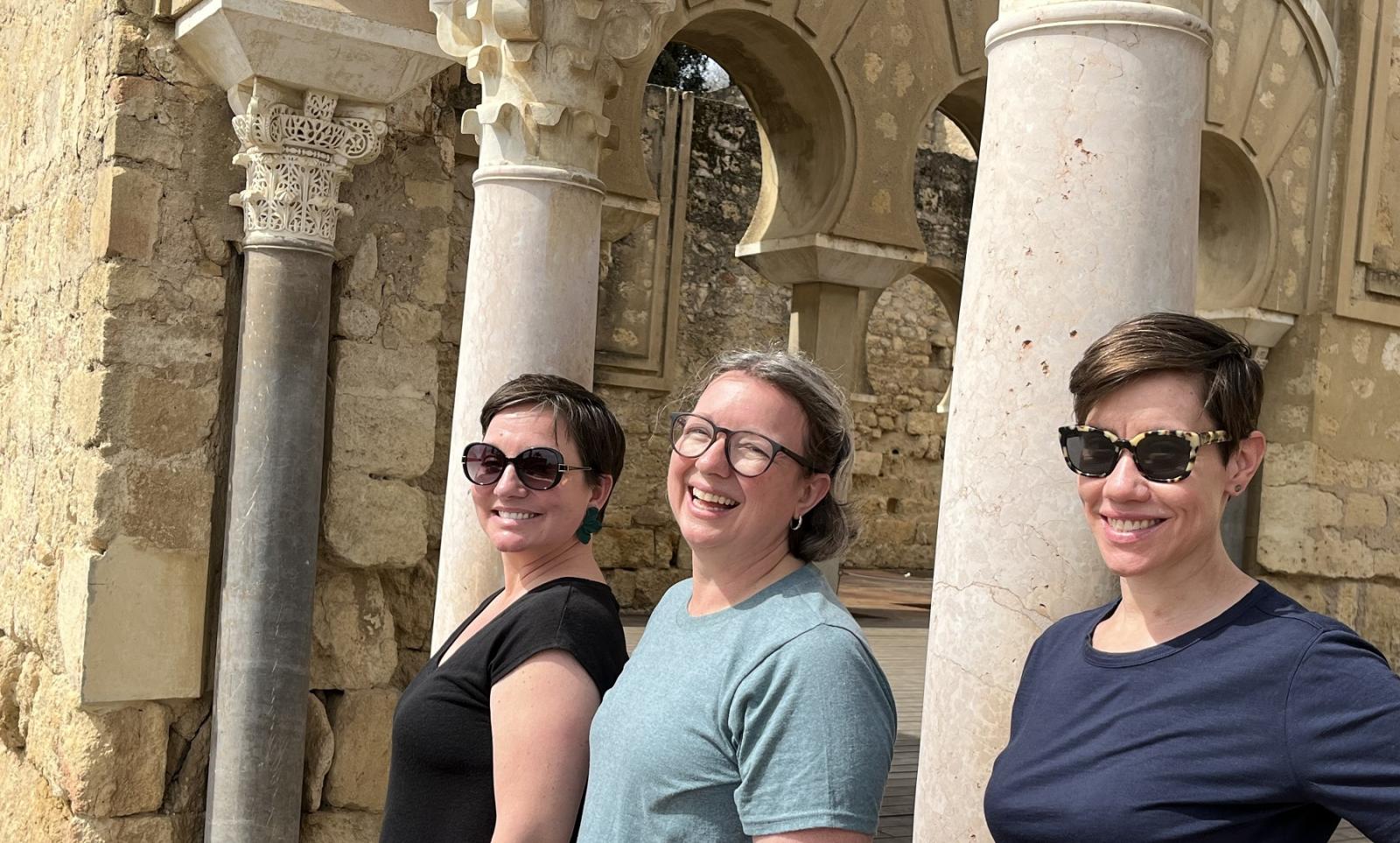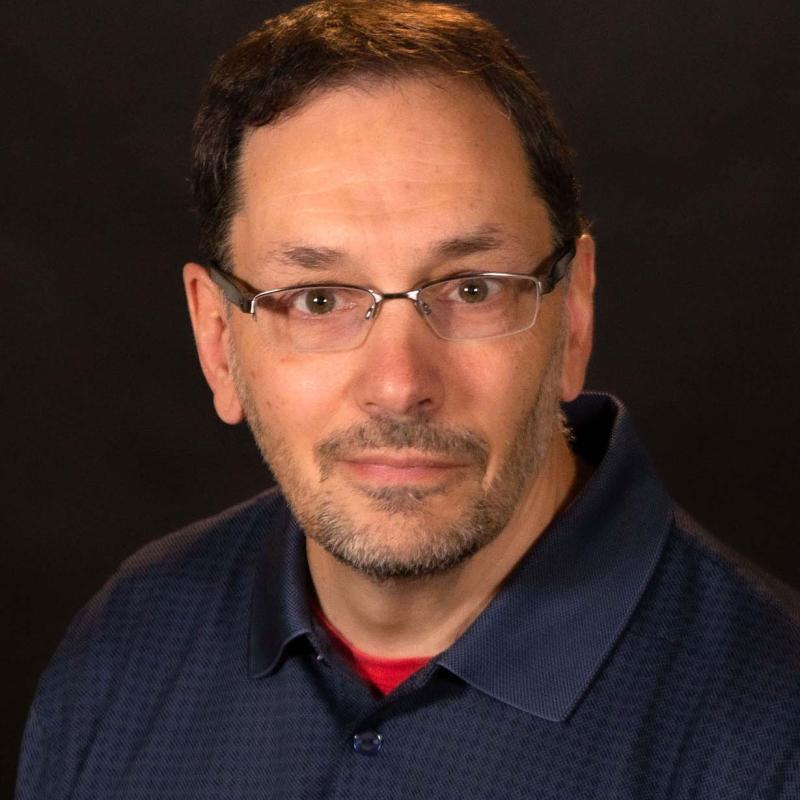What started as a shared interest in 13th-century Spain has turned into a joyous two-year interdisciplinary journey for three Lawrence University professors.
Madera Allan, associate professor of Spanish, Sara Gross Ceballos, associate professor of music, and Danielle Joyner, associate professor of art history, led an alumni trip to Spain over spring break, the third leg of an intellectual adventure built around a fascination with the Middle Ages.
The trio first crafted an interdisciplinary course in 2022, exploring the intersections of art, music, and literature found in the hundreds of 13th-century songs and miniatures that are part of the Cantigas de Santa Maria. That led them to co-teaching a D-Term course that featured a trip to Toledo, Spain, where the topics explored in the earlier course came alive with exploration of the places and cultural dynamics that define that stretch of European history. Twenty students and two alumni traveled with the three scholars for the two-week course.
And this spring, Allan, Ceballos, and Joyner guided an alumni version of the trip, Medieval Delights in Modern Spain. The trip explored and celebrated the cultural legacies of the Middle Ages that endure in modern Spain. The group traveled through Al-Andalus, examined how the diverse Christian, Muslim, and Jewish communities that populated these lands at the time contributed to the artistic and cultural traditions that make the study of medieval Spain so fascinating. The trip included visits to Madrid, Toledo, Córdoba, and Granada.

A D-Term course in December 2022 included a trip to Spain.
“These are manuscripts made in the 13th century that record songs celebrating miracles attributed to the Virgin Mary,” Joyner said of the Cantigas de Santa Maria and the interdisciplinary spark that first brought her, Allan, and Ceballos together. “Several of them also contain notated music for the songs and truly beautiful, and sometimes very weird, imagery depicting their stories. Because it’s 13th-century Spain, the relationships among the cultures occupying the peninsula are tightly woven and cross-pollinating and, yes, sometimes at odds with each other. Nonetheless, the mix of Islamic, Jewish, and Christian traditions in Spain was unique in European history. … Once the three of us started working together, the hardest part became narrowing down which songs and stories to choose because there are so many fascinating, funny, and weird possibilities.”
Teaching and learning
The three-unit course grew out of those initial conversations, with Allan, Ceballos, and Joyner jointly teaching the course, and all three learning along the way.
“Collaborating with Danielle and Madera was amazing,” Ceballos said. “We learned so much from one another, and very often that learning happened live in the classroom as we each took turns presenting materials and leading discussion. I imagine this was a pretty unique experience for some students to see their professors learning right along with them, asking questions, getting things wrong, and gaining new perspectives.”
None of them wanted the class to end.
“The class was so much fun,” Joyner said. “The students liked it, we liked it. We got to the end and thought, we have to do this again.”
So they did.
Learn more about Lawrence Alumni trips
Allan has been on the Spanish faculty at Lawrence since 2008. Her scholarship is focused on community formation in late medieval and early modern Spain and the colonial era of Latin America.
Ceballos has taught musicology at Lawrence since 2008. Her scholarly work focuses on 18th century keyboard music. She has a fascination with early music and often performs on harpsichord, keyboards, and ukulele.
Joyner joined the art history faculty in 2018. Her scholarly work has most recently focused on intersections between the natural environment and the arts, publishing on topics such as sixth-century bird-shaped brooches, the ephemerality of gardens, animals in Anglo-Saxon arts, and representations of terra across the Middle Ages.
The three continue to find meaningful connections via 13th-century Spain in their respective fields. That power of shared knowledge and intersecting interests has driven this project in all three of its phases.
“They bring wisdom and intellectual enthusiasm to everything they do,” Allan said of Joyner and Ceballos. “I have learned so much from both of them. They are also models of patience and generosity—so I’m not the only one who has learned from them. The students in both iterations of the class have produced amazingly nuanced analyses incorporating architectural, musical, and literary elements.”
Taking the course to Spain
The D-Term trip took the experience to a new level. Joyner, who led the planning efforts, reached out to connections she had at Fundación Ortega-Marañon (FOM) in Toledo. With help from Yukiko Okazaki, the organization’s director of International Programs, they put together a travel course built around the Cantigas de Santa Maria.
“A number of the Cantigas refer to Toledo, and there are medieval mosques, synagogues, and churches that still stand in that extraordinary little city,” Joyner said.
The itinerary led the group from Madrid to Toledo to Córdoba and back to Madrid.
“We stayed at the FOM campus in Toledo and had a bus that took us on our various outings,” Joyner said.
A highlight was a private musical performance by the scholar Antoni Rossell. Ceballos had discovered his award-winning album, Galicia e as Cantigas de Santa Maria, during research for the earlier course.
“His album is unique in that he and his collaborators worked to make medieval Galicia and its sound worlds come alive on record, and they also endeavored to situate the Cantigas in that world,” Ceballos said. “In the opening track, you hear the creaking of a boat and the sounds of a powerful storm, and then the a cappella voices of singers praising the Virgin Mary and imploring, ‘Holy Mary, morning star, show us the way to God and guide us.’ Antoni’s performance blew me away and he was so engaging and generous.”
Hannah Frank, a senior history major from New Canaan, Connecticut, called the D-Term trip a “unique and special opportunity” for the students.
“Besides having classes with the professors throughout the term and learning historical context from them, we also got guided tours throughout Spain that were really important for me actually understanding the significance of the places we were in,” Frank said.
The D-Term course was aided by two Lawrence alumni, Robert ’79 and Janet Stevens ’82, who joined the trip. The presence of the Stevens enriched the D-Term course, and it sparked talk of a wider alumni trip.
“We could have conversations with them that followed different paths than those we had with the students,” Joyner said. “Because of their own lives and experiences, they posed questions that likely would never come out of a 20-year-old’s mouth, and those questions made us think in different ways about what we were doing. It was fantastic, and it made me want to try it on a bigger scale.”
With 14 alumni and family joining them on the spring break trip, it was the next step in an academic adventure that Allan, Ceballos, and Joyner continue to embrace.
“I do always want to share the medieval love with anyone who wants to listen, and sometimes even with people who don’t,” Joyner said. “We knew that we had an exciting and unique way of thinking about Spain, and we wanted to share it with another Lawrence audience. I think I can speak for Madera and Sara when I say that we firmly believe in the importance of the humanities and fine arts and that an important component of a liberal arts education is that it instills in those who are receptive a joy in life-long learning.”
Art history explores visual traditions that span history and circle the globe.
Conversation and culture combine in the Spanish program at Lawrence.
Delve into questions about why and how music has mattered to people in different times and cultures.




